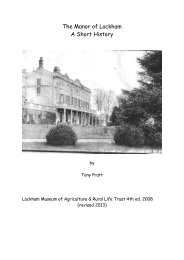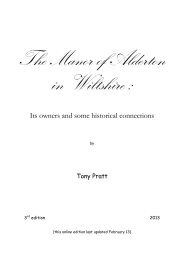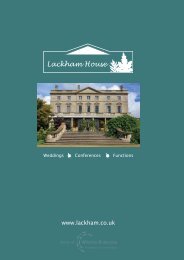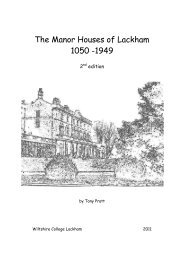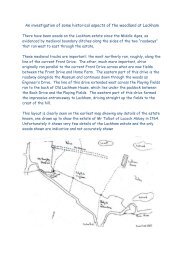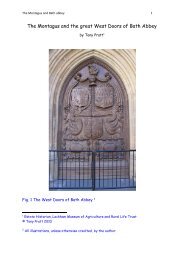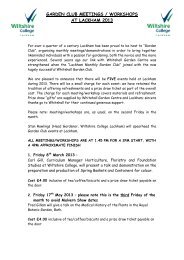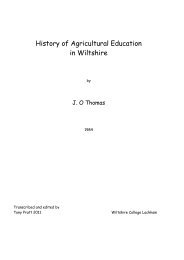Vol 1: The Bluets - Lackham Countryside Centre
Vol 1: The Bluets - Lackham Countryside Centre
Vol 1: The Bluets - Lackham Countryside Centre
You also want an ePaper? Increase the reach of your titles
YUMPU automatically turns print PDFs into web optimized ePapers that Google loves.
<strong>The</strong> <strong>Bluets</strong> 97<br />
respond to the appeal made to the Pope by the Scots. <strong>The</strong>y presented<br />
Pope Boniface with a well prepared case to show that<br />
Edward had no superiority in Scotland but that, in fact, the<br />
kingdom was in the special protection of the Holy See 416<br />
John wasn‘t in Rome long, he may have returned when the embassy failed;<br />
the Pope issued the Bull Scimus Fili instructing Edward I to leave the<br />
Scots alone. This wasn‘t actually presented to Edward until later in 1300,<br />
see below.<br />
John Bluet was back in England by October when he acknowledged that<br />
he owed 8 marks to John de Tyting to be secured on his property in<br />
Southampton,. This doesn‘t necessarily mean in the town of<br />
Southampton as at this date Southampton was often used as a<br />
geographical area and appears to have been looked on almost as a county<br />
in its own right. It is known from the Close Rolls that de Tyting was a<br />
citizen of Winchester 417 but this doesn‘t show his true importance. He<br />
could afford to lend John Bluet money as he<br />
was Mayor of Winchester on three occasions as well as being<br />
Member of Parliament…….. He made his fortune from wool and<br />
in modern terms was a multimillionaire who had many<br />
connections with France and other parts of Europe 418<br />
Wool and money were major factors of England at this period – “<br />
throughout the thirteenth century the amount of money in circulation<br />
had been increasing 419 ; the increase in the [money] supply was certainly<br />
stupendous and was supported by the influx of silver to pay for English<br />
and Scottish wool. So it is not surprising to find a wool merchant lending<br />
money.<br />
Edward invaded Scotland again in 1300 and it is clear that John Bluet<br />
416<br />
Keen, M (2003) England in the later Middle Ages 2nd ed. Routledge p27<br />
417<br />
Calendar Close Rolls Edw I vol 3 1296 – 1303 p508 dated October 28th 1302<br />
when John acknowledged the debt was now £24 6s 4d<br />
418<br />
Scobie, G Views of Medieval Winchester at<br />
http://www.communigate.co.uk/hants/somsoc/page12.phtml<br />
419<br />
See, for instance, Carpenter, D (2003) <strong>The</strong> Struggle for Mastery: Britain 1066-<br />
1284 OUP, chapter 2 generally, and p40 specifically



